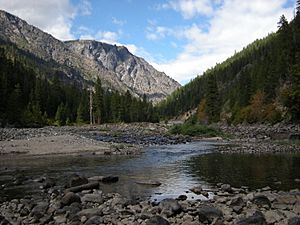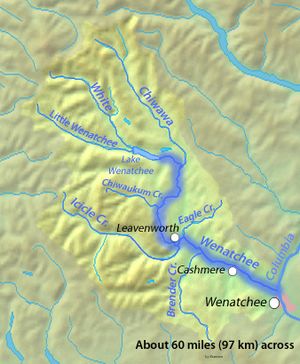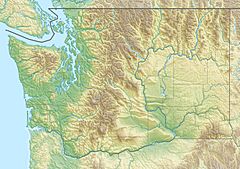Wenatchee River facts for kids
Quick facts for kids Wenatchee River |
|
|---|---|

The Wenatchee River west of Leavenworth
|
|

Map of the Wenatchee River
|
|
|
Mouth of the Wenatchee River in Washington
|
|
| Country | United States |
| State | Washington |
| County | Chelan |
| Physical characteristics | |
| Main source | Lake Wenatchee 47°48′28″N 120°43′39″W / 47.80778°N 120.72750°W |
| River mouth | Columbia River Wenatchee 47°27′19″N 120°19′28″W / 47.45528°N 120.32444°W |
| Length | 53 mi (85 km) |
| Basin features | |
| Basin size | 1,333 sq mi (3,450 km2) |
The Wenatchee River is a river in the state of Washington, USA. It starts at Lake Wenatchee and flows southeast for about 53 miles (85 km). The river then joins the larger Columbia River near the city of Wenatchee.
As it flows, the Wenatchee River passes through several towns. These include Plain, Leavenworth, Peshastin, Dryden, Cashmere, Monitor, and Wenatchee. All these towns are located in Chelan County. The river is a popular spot for fun activities like kayaking and river rafting, attracting many tourists.
Many smaller streams and rivers flow into the Wenatchee River. These are called tributaries. Some important tributaries include the Chiwawa River, Nason Creek, Peshastin Creek, and Icicle Creek. The area of land that collects water for the Wenatchee River is called its drainage basin. This basin covers about 1,333 square miles (3,452 km²).
River History
For a long time, the Wenatchee River was a natural border. It separated Okanogan County from Kittitas County. However, since Chelan County was formed around 1899, the river has been right in the middle of it.
Water Use and Dams
People have been using water from the Wenatchee River and its tributaries for a long time. Since 1891, this water has mainly been used to irrigate orchards. Irrigation means supplying water to help crops grow.
There are two small dams on the Wenatchee River. One is called the Tumwater Canyon Dam. It is located just west of the town of Leavenworth. The other is the Dryden Dam, which is a low dam near the town of Dryden.
The Tumwater Canyon Dam first provided power for a 2-mile (3.2 km) long railroad tunnel. This tunnel was used near Stevens Pass to help trains cross the Cascade Mountains. Later, starting in 1928, the dam's power was used to electrify the railroad. This helped trains run from Wenatchee to Skykomish.
River Health
The health of the Wenatchee River is important for everyone. Sometimes, chemicals that were banned many years ago can still be found in the environment. These chemicals can build up in the food chain, which means they can affect animals and even people.
In 2007, the Washington Department of Health gave advice about eating fish from the river. They suggested that people should not eat mountain whitefish caught between Leavenworth and where the river meets the Columbia River. This was because of unhealthy levels of certain substances found in the fish. Scientists and health experts continue to monitor the river to ensure its safety.
See also
 In Spanish: Río Wenatchee para niños
In Spanish: Río Wenatchee para niños


